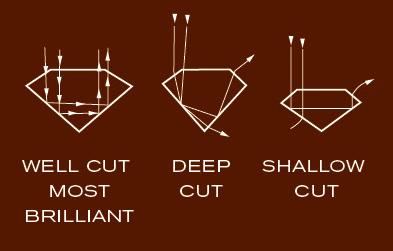The crown height of a diamond refers to the vertical measurement of the crown portion of the diamond, which is the area above the girdle (the widest part of the diamond). It is one of the key proportions that affects a diamond’s overall cut quality and visual appearance. The crown height plays a significant role in how well a diamond reflects light and how its sparkle is perceived.
Key Points About Diamond Crown Height:
Crown Height and Overall Cut:
The crown height is an important part of a diamond’s cut proportions, which determine how well the diamond will perform in terms of brilliance, fire, and scintillation.
The height of the crown is usually expressed as a percentage of the overall depth of the diamond. The depth is the total height of the diamond from the culet (bottom point) to the table (top flat surface).
Crown Height Proportions:
For a round brilliant diamond, the ideal crown height is typically between 12% and 16% of the total depth.
A crown height that is too shallow can cause the diamond to appear flat, as light may escape from the sides, reducing its brilliance and sparkle.
A crown that is too tall can make the diamond appear top-heavy, and it might lead to light leakage from the bottom of the diamond, affecting its overall light performance.
Crown Height and Brilliance:
The crown height affects the angle of the crown facets and, consequently, the way light enters and exits the diamond. Proper crown height ensures that light is reflected and refracted optimally within the stone, creating the sparkle and brilliance diamonds are known for.
When the crown height is proportioned correctly, it maximizes light return, ensuring that the diamond exhibits bright flashes of light and vibrant colours (fire).
Impact of Crown Height on Visual Appearance:
Shallow Crown Height: A crown that is too shallow may cause the diamond to look less vibrant and may reduce its overall brightness. Light can escape from the sides, diminishing the diamond’s sparkle.
Tall Crown Height: A crown that is too tall can make the diamond look overly deep or heavy, which can reduce the amount of light returning through the top of the diamond, leading to a darker appearance.
Relationship with Pavilion Angle:
The crown height is often considered alongside the pavilion angle (the angle of the lower portion of the diamond) to determine the diamond’s overall light performance. The crown and pavilion work together to reflect light properly inside the diamond, and the proportions of these angles must complement each other for optimal results.
Crown Height in Grading:
When diamonds are graded by gemological laboratories like GIA or DCLA, the crown height is taken into consideration as part of the overall cut grade. A well-proportioned crown height helps achieve a grade of Excellent or Ideal in terms of cut quality, which is a critical factor in a diamond’s value and appearance.
Ideal Crown Height:
For a round brilliant cut, an ideal crown height typically falls between 12% and 16% of the total diamond depth.
This range ensures that the crown is tall enough to allow proper light reflection, but not so tall that it causes light leakage or reduces overall brightness.
Summary of Diamond Crown Height:
Crown Height: The vertical measurement from the girdle to the table of the diamond.
Ideal Proportion: For round brilliant diamonds, the crown height is ideally between 12% and 16% of the diamond’s total depth.
Impact on Light Performance: A properly proportioned crown height ensures the diamond reflects light optimally, producing maximum brilliance and sparkle.

